KIA CARENS RHD 2018 Manual PDF
Manufacturer: KIA, Model Year: 2018, Model line: CARENS RHD, Model: KIA CARENS RHD 2018Pages: 723, PDF Size: 40.94 MB
Page 71 of 723
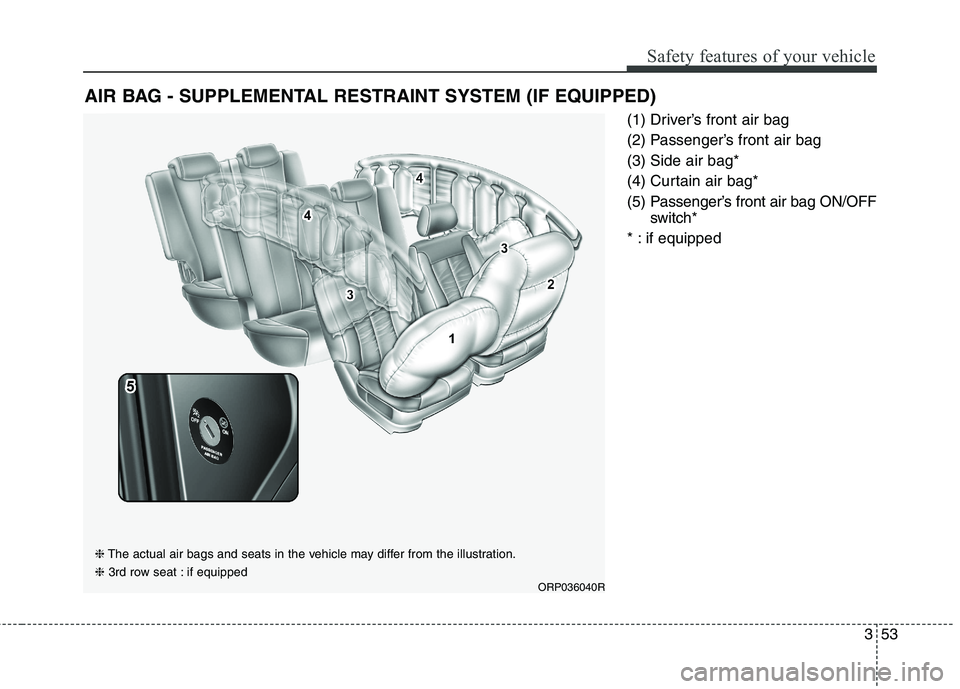
353
Safety features of your vehicle
(1) Driver’s front air bag
(2) Passenger’s front air bag(3) Side air bag*
(4) Curtain air bag*
(5) Passenger’s front air bag ON/OFFswitch*
* : if equipped
AIR BAG - SUPPLEMENTAL RESTRAINT SYSTEM (IF EQUIPPED)
ORP036040R
❈
The actual air bags and seats in the vehicle may differ from the illustration.
❈ 3rd row seat : if equipped
Page 72 of 723
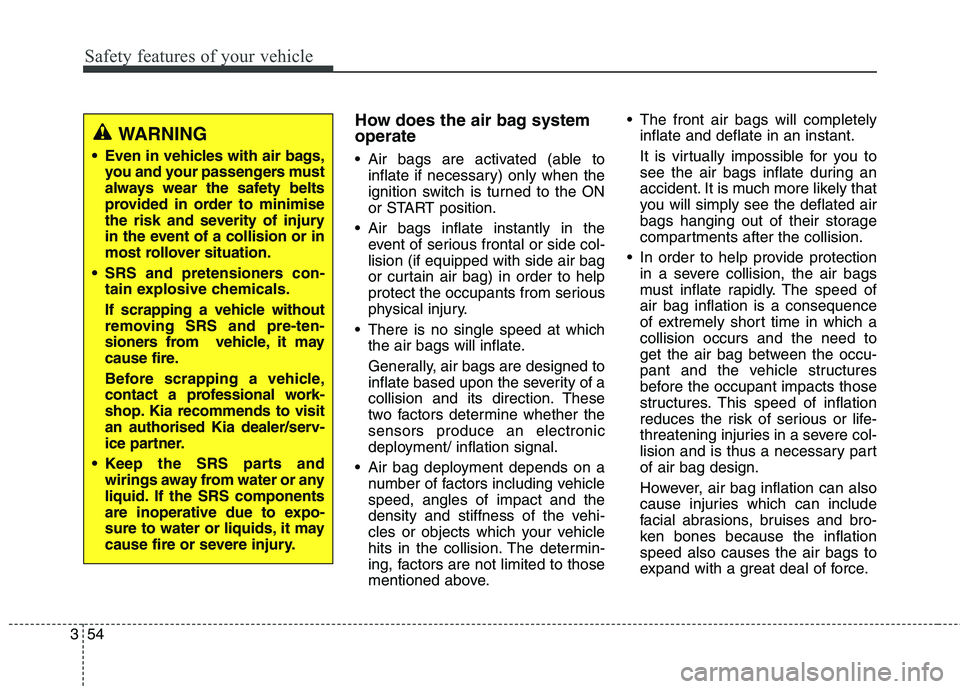
Safety features of your vehicle
54
3
How does the air bag system operate
Air bags are activated (able to
inflate if necessary) only when the
ignition switch is turned to the ON
or START position.
Air bags inflate instantly in the event of serious frontal or side col-lision (if equipped with side air bag
or curtain air bag) in order to help
protect the occupants from serious
physical injury.
There is no single speed at which the air bags will inflate.
Generally, air bags are designed to
inflate based upon the severity of a
collision and its direction. These
two factors determine whether thesensors produce an electronic
deployment/ inflation signal.
Air bag deployment depends on a number of factors including vehiclespeed, angles of impact and the
density and stiffness of the vehi-
cles or objects which your vehicle
hits in the collision. The determin-
ing, factors are not limited to those
mentioned above. The front air bags will completely
inflate and deflate in an instant.
It is virtually impossible for you to
see the air bags inflate during an
accident. It is much more likely that
you will simply see the deflated air
bags hanging out of their storage
compartments after the collision.
In order to help provide protection in a severe collision, the air bags
must inflate rapidly. The speed ofair bag inflation is a consequence
of extremely short time in which acollision occurs and the need to
get the air bag between the occu-
pant and the vehicle structures
before the occupant impacts those
structures. This speed of inflation
reduces the risk of serious or life-
threatening injuries in a severe col-
lision and is thus a necessary partof air bag design.
However, air bag inflation can also
cause injuries which can include
facial abrasions, bruises and bro-
ken bones because the inflationspeed also causes the air bags to
expand with a great deal of force.WARNING
Even in vehicles with air bags, you and your passengers must
always wear the safety belts
provided in order to minimise
the risk and severity of injury
in the event of a collision or in
most rollover situation.
SRS and pretensioners con- tain explosive chemicals.
If scrapping a vehicle without
removing SRS and pre-ten-
sioners from vehicle, it may
cause fire.
Before scrapping a vehicle,
contact a professional work-
shop. Kia recommends to visit
an authorised Kia dealer/serv-
ice partner.
Keep the SRS parts and wirings away from water or any
liquid. If the SRS components
are inoperative due to expo-
sure to water or liquids, it may
cause fire or severe injury.
Page 73 of 723

355
Safety features of your vehicle
There are even circumstancesunder which contact with the
steering wheel air bag can cause
fatal injuries, especially if the
occupant is positioned exces-
sively close to the steering wheel.Noise and smoke
When the air bags inflate, they make
a loud noise and they leave smoke
and powder in the air inside of the
vehicle. This is normal and is a result
of the ignition of the air bag inflator.
After the air bag inflates, you may
feel substantial discomfort in breath-
ing due to the contact of your chestwith both the seat belt and the air
bag, as well as from breathing the
smoke and powder. Open your
doors and/or windows as soon as
possible after impact in order to
reduce discomfort and prevent
prolonged exposure to the smoke
and powder.
Though smoke and powder are non-
toxic, it may cause irritation to the
skin (eyes, nose and throat, etc.). If
this is the case, wash and rinse with
cold water immediately and consult
the doctor if the symptom persists.
WARNING
To avoid severe personal injury or death caused by
deploying air bags in a colli-
sion, the driver should sit as
far back from the ste ering
wheel air bag. The front pas-
senger should always move
their seat as far back as pos-
sible and sit back in their seat.
Air bag inflates instantly in an event of a collision, passen-
gers may be injured by the air
bag expansion force if they
are not in a proper position.
Air bag inflation may cause injuries including facial or
bodily abrasions, injuries from
broken glasses or burns.
WARNING
When the air bags deploy, the air bag related parts in the steering wheel and/or instru-ment panel and/or in both
sides of the roof rails above
the front and rear doors are
very hot. To prevent injury, do
not touch the air bag storageareas internal components
immediately after an air baghas inflated.
Do not install or place any accessories near air bag
deployment areas, such as
the instrument panel, win-
dows, pillars, and roof rails.
Page 74 of 723
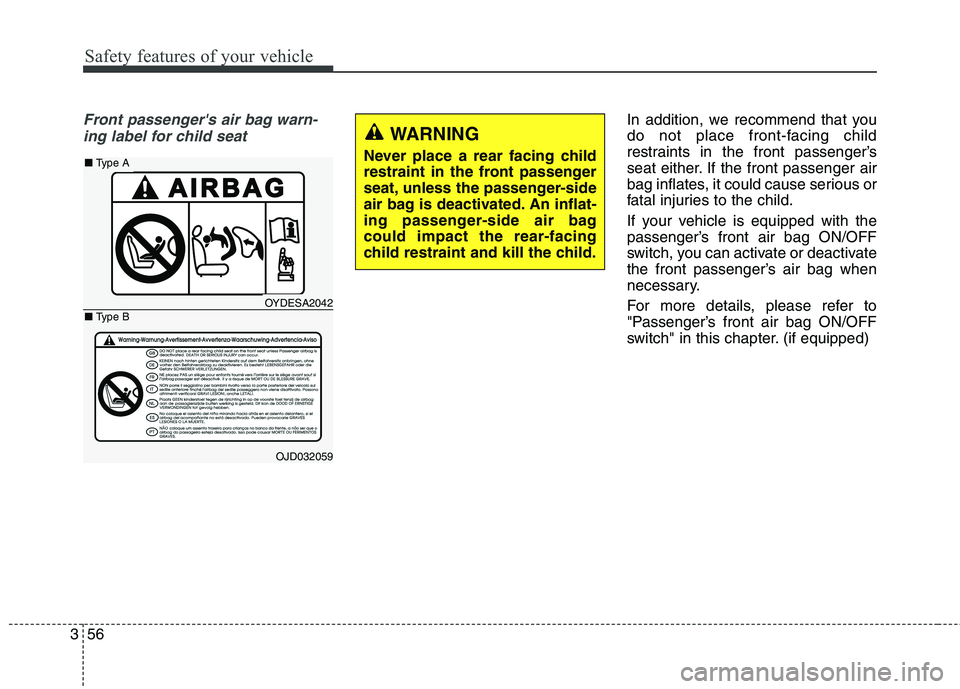
Safety features of your vehicle
56
3
Front passenger's air bag warn-
ing label for child seatIn addition, we recommend that you
do not place front-facing child
restraints in the front passenger’s
seat either. If the front passenger air
bag inflates, it could cause serious or
fatal injuries to the child.
If your vehicle is equipped with the
passenger’s front air bag ON/OFF
switch, you can activate or deactivate
the front passenger’s air bag when
necessary.
For more details, please refer to
"Passenger’s front air bag ON/OFF
switch" in this chapter. (if equipped)
OYDESA2042
OJD032059
■ Type A
■ Type B
WARNING
Never place a rear facing child
restraint in the front passenger
seat, unless the passenger-side
air bag is deactivated. An inflat-
ing passenger-side air bag
could impact the rear-facing
child restraint and kill the child.
Page 75 of 723
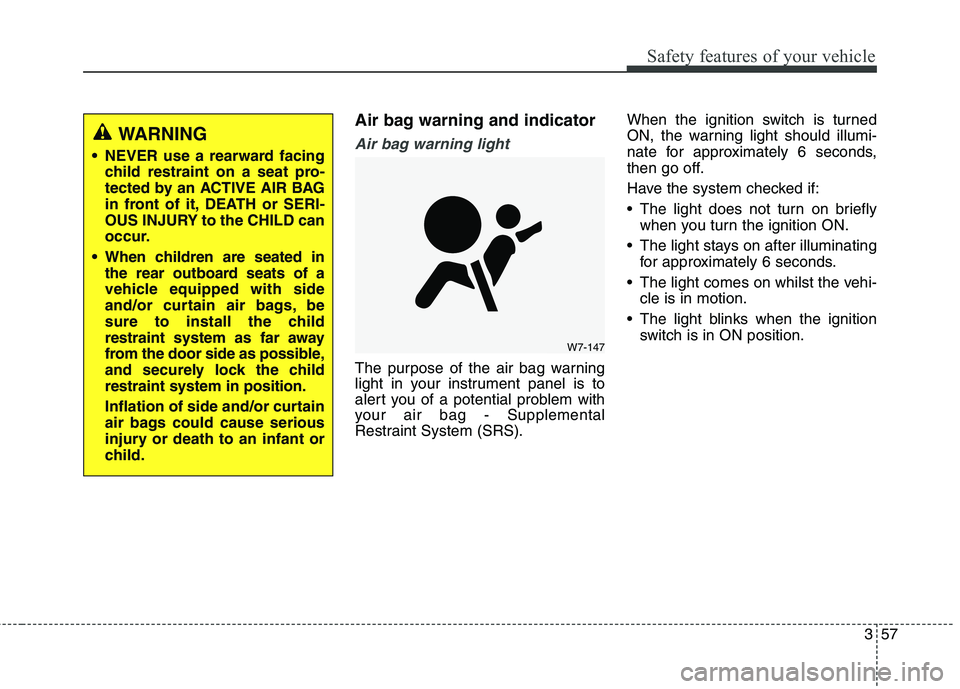
357
Safety features of your vehicle
Air bag warning and indicator
Air bag warning light
The purpose of the air bag warning
light in your instrument panel is to
alert you of a potential problem with
your air bag - Supplemental
Restraint System (SRS).When the ignition switch is turned
ON, the warning light should illumi-
nate for approximately 6 seconds,
then go off.
Have the system checked if:
The light does not turn on briefly
when you turn the ignition ON.
The light stays on after illuminating for approximately 6 seconds.
The light comes on whilst the vehi- cle is in motion.
The light blinks when the ignition switch is in ON position.
W7-147
WARNING
NEVER use a rearward facing child restraint on a seat pro-
tected by an ACTIVE AIR BAG
in front of it, DEATH or SERI-
OUS INJURY to the CHILD can
occur.
When children are seated in the rear outboard seats of a
vehicle equipped with side
and/or curtain air bags, be
sure to install the child
restraint system as far away
from the door side as possible,
and securely lock the childrestraint system in position.
Inflation of side and/or curtain
air bags could cause serious
injury or death to an infant or
child.
Page 76 of 723
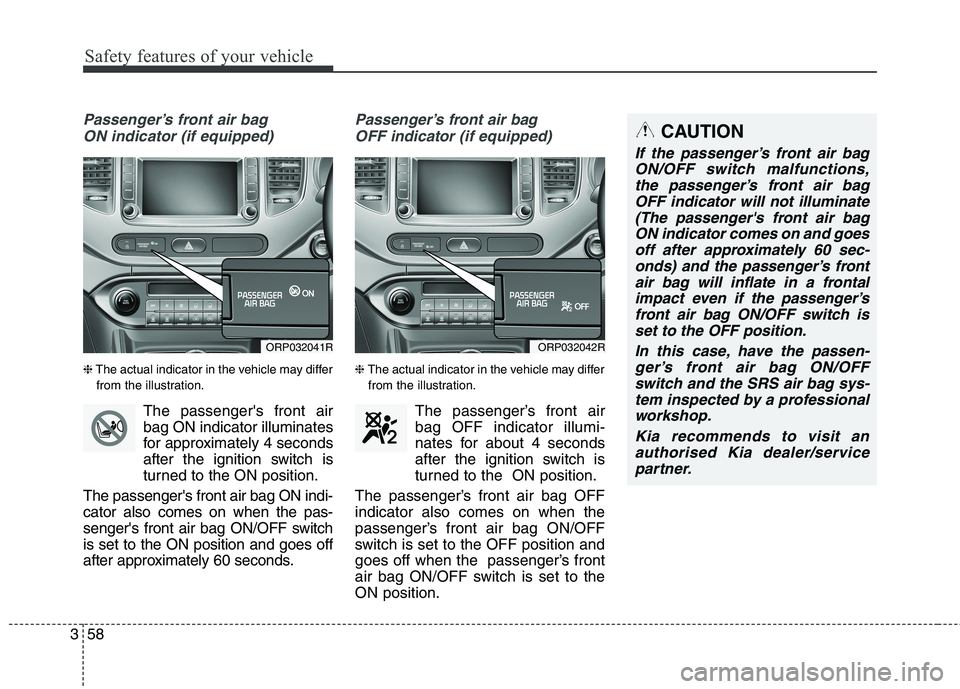
Safety features of your vehicle
58
3
Passenger’s front air bag
ON indicator (if equipped)
❈ The actual indicator in the vehicle may differ
from the illustration.
The passenger's front airbag ON indicator illuminates
for approximately 4 seconds
after the ignition switch is
turned to the ON position.
The passenger's front air bag ON indi-cator also comes on when the pas-
senger's front air bag ON/OFF switchis set to the ON position and goes off
after approximately 60 seconds.
Passenger’s front air bag OFF indicator (if equipped)
❈The actual indicator in the vehicle may differ
from the illustration.
The passenger’s front airbag OFF indicator illumi-
nates for about 4 seconds
after the ignition switch is
turned to the ON position.
The passenger’s front air bag OFFindicator also comes on when the
passenger’s front air bag ON/OFF
switch is set to the OFF position and
goes off when the passenger’s front
air bag ON/OFF switch is set to theON position.
ORP032041RORP032042R
CAUTION
If the passenger’s front air bag ON/OFF switch malfunctions,the passenger’s front air bagOFF indicator will not illuminate (The passenger's front air bagON indicator comes on and goesoff after approximately 60 sec- onds) and the passenger’s frontair bag will inflate in a frontalimpact even if the passenger’s front air bag ON/OFF switch isset to the OFF position.
In this case, have the passen-ger’s front air bag ON/OFFswitch and the SRS air bag sys- tem inspected by a professionalworkshop.
Kia recommends to visit anauthorised Kia dealer/servicepartner.
Page 77 of 723
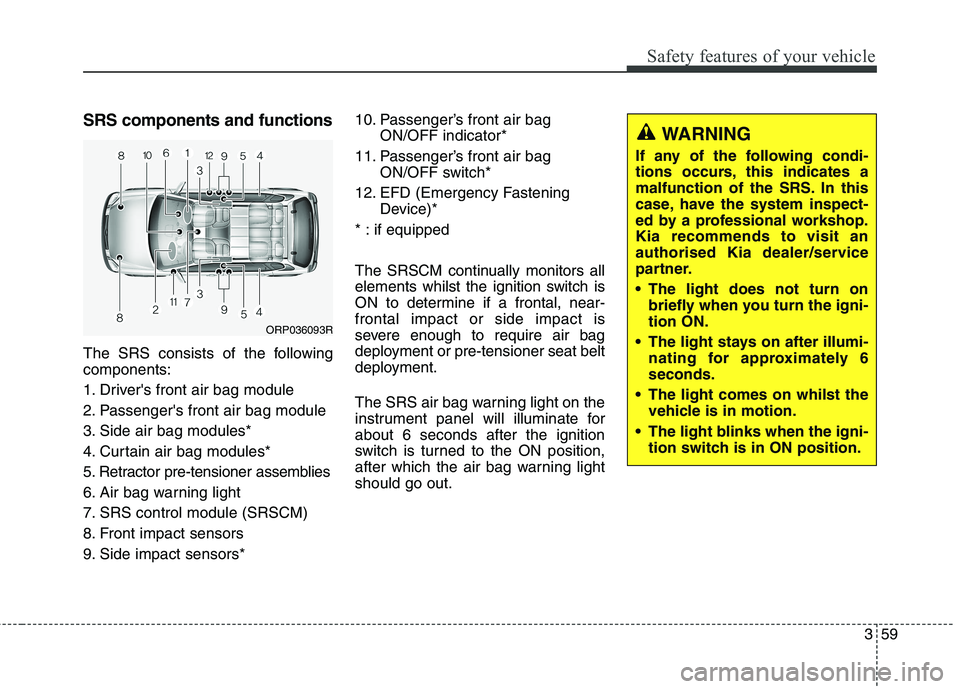
359
Safety features of your vehicle
SRS components and functions
The SRS consists of the following components:
1. Driver's front air bag module
2. Passenger's front air bag module
3. Side air bag modules*
4. Curtain air bag modules*
5. Retractor pre-tensioner assemblies
6. Air bag warning light
7. SRS control module (SRSCM)
8. Front impact sensors
9. Side impact sensors*10. Passenger’s front air bag
ON/OFF indicator*
11. Passenger’s front air bag ON/OFF switch*
12. EFD (Emergency Fastening Device)*
* : if equipped
The SRSCM continually monitors all
elements whilst the ignition switch is
ON to determine if a frontal, near-frontal impact or side impact is
severe enough to require air bag
deployment or pre-tensioner seat belt
deployment.
The SRS air bag warning light on the
instrument panel will illuminate forabout 6 seconds after the ignition
switch is turned to the ON position,
after which the air bag warning lightshould go out.
ORP036093R
WARNING
If any of the following condi-
tions occurs, this indicates a
malfunction of the SRS. In this
case, have the system inspect-
ed by a professional workshop.Kia recommends to visit an
authorised Kia dealer/service
partner.
The light does not turn on briefly when you turn the igni- tion ON.
The light stays on after illumi- nating for approximately 6seconds.
The light comes on whilst the vehicle is in motion.
The light blinks when the igni- tion switch is in ON position.
Page 78 of 723
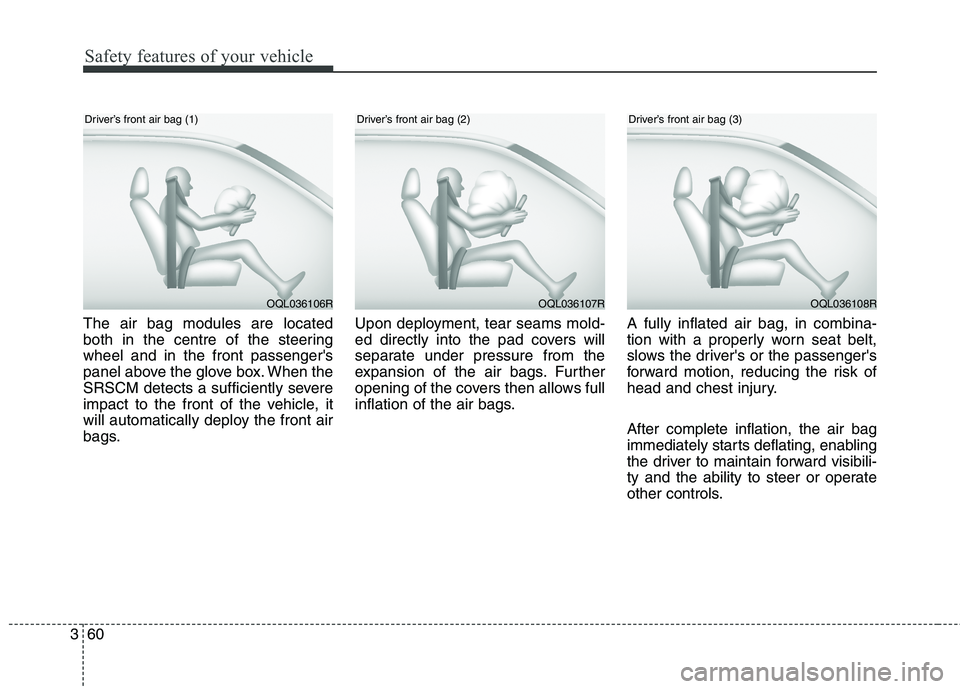
Safety features of your vehicle
60
3
The air bag modules are located
both in the centre of the steeringwheel and in the front passenger's
panel above the glove box. When the
SRSCM detects a sufficiently severe
impact to the front of the vehicle, it
will automatically deploy the front air
bags. Upon deployment, tear seams mold-
ed directly into the pad covers will
separate under pressure from the
expansion of the air bags. Further
opening of the covers then allows full
inflation of the air bags.
A fully inflated air bag, in combina-
tion with a properly worn seat belt,
slows the driver's or the passenger's
forward motion, reducing the risk of
head and chest injury. After complete inflation, the air bag
immediately starts deflating, enabling
the driver to maintain forward visibili-
ty and the ability to steer or operate
other controls.
OQL036106R
Driver’s front air bag (1)
OQL036107R
Driver’s front air bag (2)
OQL036108R
Driver’s front air bag (3)
Page 79 of 723
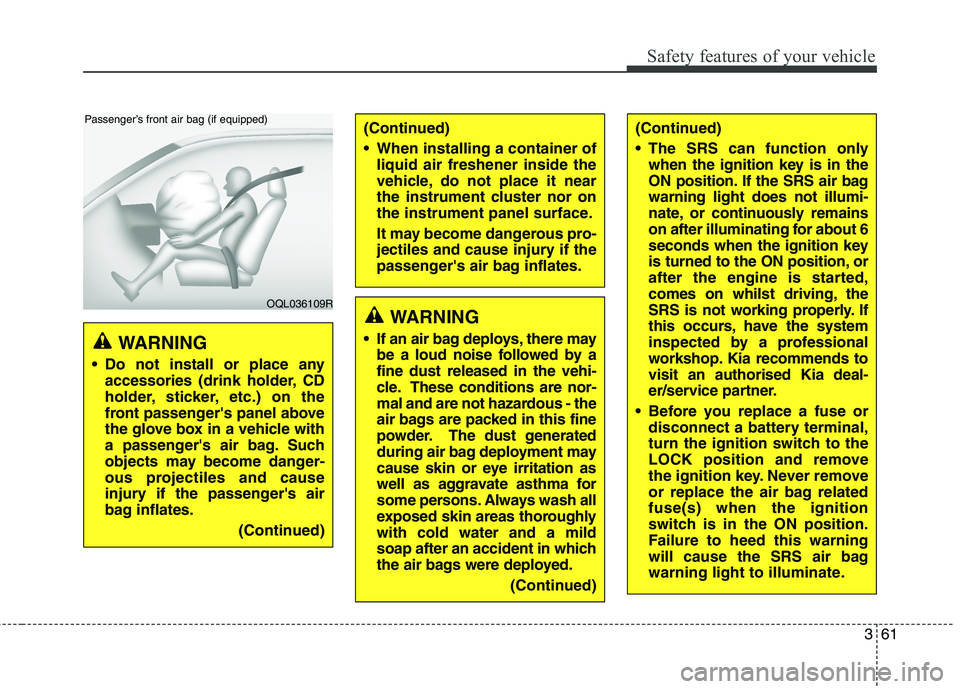
361
Safety features of your vehicle
WARNING
Do not install or place any accessories (drink holder, CD
holder, sticker, etc.) on the
front passenger's panel above
the glove box in a vehicle with
a passenger's air bag. Such
objects may become danger-
ous projectiles and cause
injury if the passenger's air
bag inflates.
(Continued)
(Continued)
When installing a container ofliquid air freshener inside the
vehicle, do not place it near
the instrument cluster nor on
the instrument panel surface.
It may become dangerous pro-
jectiles and cause injury if the
passenger's air bag inflates.
OQL036109R
Passenger’s front air bag (if equipped)
WARNING
If an air bag deploys, there may be a loud noise followed by a fine dust released in the vehi-
cle. These conditions are nor-
mal and are not hazardous - the
air bags are packed in this fine
powder. The dust generated
during air bag deployment may
cause skin or eye irritation as
well as aggravate asthma for
some persons. Always wash all
exposed skin areas thoroughlywith cold water and a mild
soap after an accident in which
the air bags were deployed.
(Continued)
(Continued)
The SRS can function onlywhen the ignition key is in the
ON position. If the SRS air bagwarning light does not illumi-
nate, or continuously remains
on after illuminating for about 6
seconds when the ignition key
is turned to the ON position, or
after the engine is started,
comes on whilst driving, the
SRS is not working properly. If
this occurs, have the system
inspected by a professional
workshop. Kia recommends tovisit an authorised Kia deal-
er/service partner.
Before you replace a fuse or disconnect a battery terminal,
turn the ignition switch to the
LOCK position and remove
the ignition key. Never remove
or replace the air bag relatedfuse(s) when the ignition
switch is in the ON position.
Failure to heed this warning
will cause the SRS air bag
warning light to illuminate.
Page 80 of 723
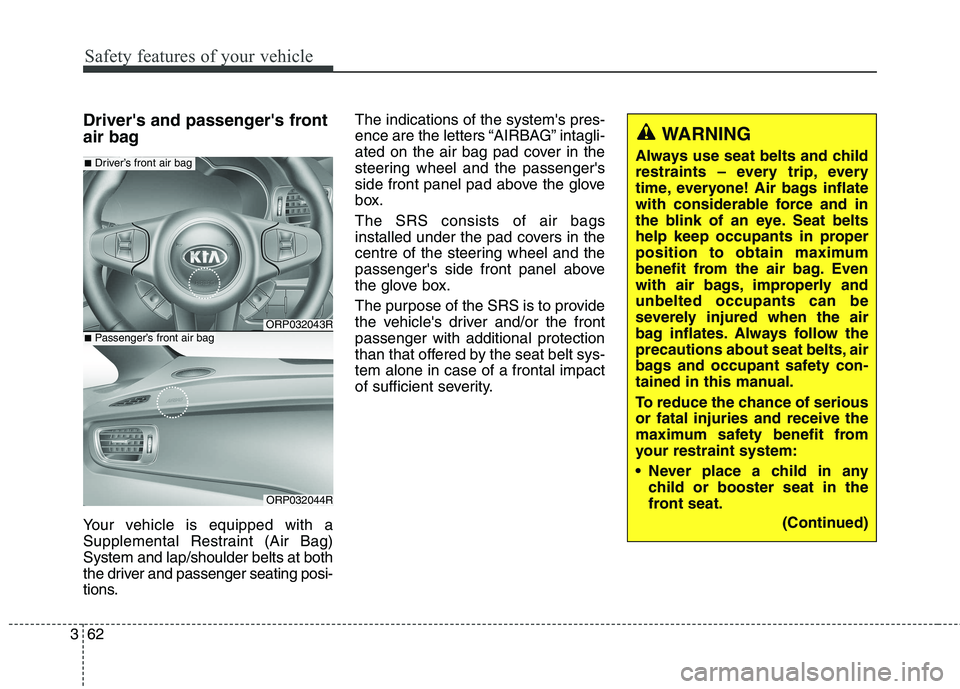
Safety features of your vehicle
62
3
Driver's and passenger's front
air bag
Your vehicle is equipped with a
Supplemental Restraint (Air Bag)System and lap/shoulder belts at both
the driver and passenger seating posi-
tions. The indications of the system's pres-
ence are the letters “AIRBAG” intagli-
ated on the air bag pad cover in the
steering wheel and the passenger's
side front panel pad above the glove
box. The SRS consists of air bags
installed under the pad covers in the
centre of the steering wheel and the
passenger's side front panel above
the glove box.
The purpose of the SRS is to provide
the vehicle's driver and/or the frontpassenger with additional protection
than that offered by the seat belt sys-tem alone in case of a frontal impact
of sufficient severity.
ORP032043R
■
Driver’s front air bag
ORP032044R
■Passenger’s front air bag
WARNING
Always use seat belts and child
restraints – every trip, every
time, everyone! Air bags inflate
with considerable force and in
the blink of an eye. Seat belts
help keep occupants in proper
position to obtain maximum
benefit from the air bag. Even
with air bags, improperly andunbelted occupants can be
severely injured when the air
bag inflates. Always follow the
precautions about seat belts, air
bags and occupant safety con-
tained in this manual.
To reduce the chance of serious or fatal injuries and receive the
maximum safety benefit from
your restraint system:
Never place a child in any child or booster seat in the
front seat.
(Continued)